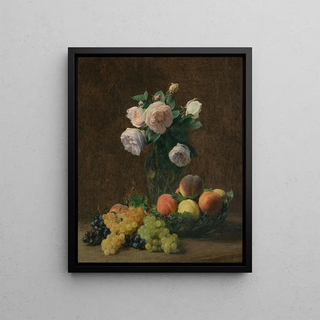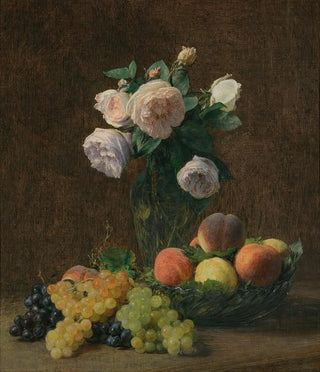Art print | Still life, vase of roses, peaches, and grapes - Henri Fantin-Latour


View from behind

Frame (optional)
Nature morte, vase of roses, peaches, and grapes - Henri Fantin-Latour – Captivating Introduction
The still life, vase of roses, peaches, and grapes, an iconic work by Henri Fantin-Latour, reveals itself as an ode to the fleeting beauty of nature. In this composition, the artist succeeds in capturing the very essence of life through a harmonious arrangement of flowers and fruits. Each element, carefully placed, tells a story, evoking the delicacy of roses, the sweetness of peaches, and the richness of grapes. Entering this universe, the viewer is invited to contemplate not only the splendor of nature but also Fantin-Latour's unparalleled talent, who manages to transcend mere realism to touch pure emotion.
Style and uniqueness of the work
Fantin-Latour's style is distinguished by its ability to blend realism with an almost poetic sensitivity. In this still life, the roses, in a delicate pink, seem to vibrate under the light, while the peaches, with golden hues, add a palpable warmth to the composition. The grapes, in a deep violet, bring a touch of contrast, creating a captivating visual dynamic. Every detail is meticulously crafted, from the petals to the reflections of the fruits, demonstrating impressive technical mastery. The work does not merely depict inanimate objects; it breathes vibrant life into each element, transforming the canvas into a truly sensory painting where colors and textures dialogue harmoniously.
The artist and his influence
Henri Fantin-Latour, a major figure of the 19th century, skillfully navigated between the artistic currents of his time while remaining faithful to his personal vision. His work is rooted in the realism movement, but he was also influenced by the emerging Impressionism, which allowed him to develop a unique style. Fantin-Latour captured the beauty of everyday life, often focusing on intimate subjects such as flowers and fruits, which reveal a deep sensitivity to nature. His influence endures today, inspiring many contemporary artists to explore the relationship between art and the natural world.

Matte finish

View from behind

Frame (optional)
Nature morte, vase of roses, peaches, and grapes - Henri Fantin-Latour – Captivating Introduction
The still life, vase of roses, peaches, and grapes, an iconic work by Henri Fantin-Latour, reveals itself as an ode to the fleeting beauty of nature. In this composition, the artist succeeds in capturing the very essence of life through a harmonious arrangement of flowers and fruits. Each element, carefully placed, tells a story, evoking the delicacy of roses, the sweetness of peaches, and the richness of grapes. Entering this universe, the viewer is invited to contemplate not only the splendor of nature but also Fantin-Latour's unparalleled talent, who manages to transcend mere realism to touch pure emotion.
Style and uniqueness of the work
Fantin-Latour's style is distinguished by its ability to blend realism with an almost poetic sensitivity. In this still life, the roses, in a delicate pink, seem to vibrate under the light, while the peaches, with golden hues, add a palpable warmth to the composition. The grapes, in a deep violet, bring a touch of contrast, creating a captivating visual dynamic. Every detail is meticulously crafted, from the petals to the reflections of the fruits, demonstrating impressive technical mastery. The work does not merely depict inanimate objects; it breathes vibrant life into each element, transforming the canvas into a truly sensory painting where colors and textures dialogue harmoniously.
The artist and his influence
Henri Fantin-Latour, a major figure of the 19th century, skillfully navigated between the artistic currents of his time while remaining faithful to his personal vision. His work is rooted in the realism movement, but he was also influenced by the emerging Impressionism, which allowed him to develop a unique style. Fantin-Latour captured the beauty of everyday life, often focusing on intimate subjects such as flowers and fruits, which reveal a deep sensitivity to nature. His influence endures today, inspiring many contemporary artists to explore the relationship between art and the natural world.






